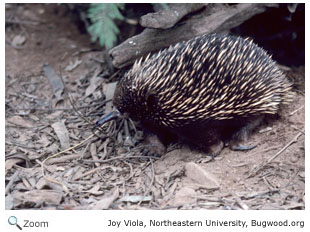Additional Information
Key:  Profile Profile  Photos Photos  Video Video  Audio Audio
Echidna  
Echidna are also called spiny anteaters. It uses its long tongue to capture ants, termites, and worms.
Source: San Diego Zoo Intended Audience: Students Reading Level: Elementary/Middle School
Echidnas  
Did you know that echidnas vary in color depending on where they live in Australia and New Guinea? Read more about these unique monotremes.
Source: New South Wales Department of Environment & Conservation Intended Audience: General Reading Level: Middle School
Echidnas  
When the echidna is threatened, it curls up in a ball to protect it fur covered belly. Learn more!
Source: Our Animals Intended Audience: Students Reading Level: Elementary School
Echidna 
Print out a diagram of an echidna and learn more at this site for kids.
Source: Enchanted Learning Intended Audience: Students Reading Level: Elementary School
Eastern Long-beaked Echidna - Zaglossus bartoni     
The eastern long-beaked echidna is found in Indonesia and Papua New Guinea.
Source: Arkive Intended Audience: General Reading Level: Middle School
Short-beaked Echidna - Tachyglossus aculeatus      
The short -beaked echidna is found in Australia, Indonesia, and Papua New Guinea.
Source: Arkive Intended Audience: General Reading Level: Middle School
Short-beaked Echidna - Tachyglossus aculeatus     
The short -beaked echidna is found in a variety of habitats including open woodlands, savanna, agricultural areas, semi-arid, and arid regions.
Source: Animal Diversity Web Intended Audience: General Reading Level: Middle School
Short-beaked Echidna - Tachyglossus aculeatus      
Echidnas don't have true pouches, they have pouch-like folds of skin that hold their babies. Speaking of babies, have you ever seen a puggle? That's what a baby echidna is called. You can see two here: baby short-beaked echidna.
Source: Perth Zoo Intended Audience: General Reading Level: Elementary/Middle School
Short-beaked Echidna- Tachyglossus aculeatus     
The echidna's rear feet point backwards. This helps them dig, but it give them a funny rolling walk! Learn more!
Source: Philadelphia Zoo Intended Audience: Students Reading Level: Elementary/Middle School
Short-beaked Echidna - Tachyglossus aculeatus     
Echidnas are shy creatures who live alone. Find out more here!
Source: St. Louis Zoo Intended Audience: Students Reading Level: Elementary/Middle School Teacher Section:Yes
Short-beaked Echidna - Tachyglossus aculeatus     
Learn more about the short-beaked echidna and try your hand at a crossword puzzle or pattern for kids to sew a baby echidna.
Source: Pelican Lagoon Research & Wildlife Centre Intended Audience: General Reading Level: Middle School
Sir David's Long-beaked Echidna - Zaglossus attenboroughi    
This article from the BBC looks at evidence that a species of long-beaked echidna named after TV naturalist Sir David Attenborough, is not extinct as previously thought.
Source: BBC Intended Audience: General Reading Level: Middle School
Western Long-beaked Echidna - Zaglossus bruijnii     
The western long-beaked echidna is found in Indonesia .
Source: Arkive Intended Audience: General Reading Level: Middle School
Long-beaked Echidna  
Find out what it takes to study the rare and elusive long-beaked echidna.
Source: New York Times Intended Audience: General Reading Level: Middle School
Western Long-beaked Echidna - Zaglossus bruijnii    
The long-beaked echidna has a long, downcurved snout. Learn more here.
Source: Animal Diversity Web Intended Audience: General Reading Level: Middle School
|

